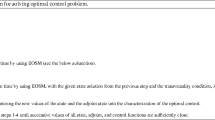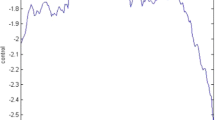Abstract
Many real-world dynamics can be modeled as nonlinear time-delay systems. In order to capture a more realistic model for system dynamics, the exact values of time-delay should be taken into account. For nonlinear time-delay systems, the estimation of delays in both state and output equations is discussed. A cost function is defined based on least-square error between actual and estimated values of the output measurement. The value of time-delays in the nonlinear system are then derived using a gradient-based optimization method. Because of the implicit description of the cost function with respect to the delay value, its gradients cannot be obtained by standard analytical differentiation rules. In this case, the optimal computational methods are utilized to derive two formulas for computing the gradient. An optimization scheme is then formulated to estimate both state and output delays. The effectiveness of the proposed estimation method is finally demonstrated using the simulation results on a benchmark chemical process.




Similar content being viewed by others
References
Chai, Q., Yang, C.H., Teo, K.L., Gui, W.H.: Optimal control of an industrial-scale evaporation process: sodium aluminate solution. Control Eng. Pract. 20(6), 618–628 (2012)
Tengel, T., Sethson, I., Francis, M.S.: Conformational analysis by CD and NMR spectroscopy of a peptide encompassing the amphipathic domain of YopD from yersinia. Eur. J. Biochem. 269(15), 3659–3668 (2002)
Na, J., Ren, X., Costa-Castello, R., Guo, Y.: Repetitive control of servo systems with time delays. Robot. Auton. Syst. 62(3), 319–329 (2014)
Cheng, G., Wang, L., Loxton, R., Lin, Q.: Robust optimal control of a microbial batch culture process. J. Optim. Theory Appl. 167(1), 342–362 (2015)
Niculescu, S.I.: Delay Effects on Stability: A Robust Control Approach. Springer, Berlin (2001)
Michiels, W., Niculescu, S.I.: Stability, Control, and Computation for Time-Delay Systems: An Eigenvalue-Based Approach, vol. 10, pp. 407–435. Society for Industrial and Applied Mathematics (SIAM), Philadelphia, PA (2014). https://epubs.siam.org/doi/book/10.1137/1.9781611973631
Pignotti, C.: A note on stabilization of locally damped wave equations with time delay. Syst. Control Lett. 61(1), 92–97 (2012)
Biegler, L.T., Campbell, S.L., Mehrmann, V.: Control and Optimization with Differential-Algebraic Constraints. Advances in Design and Control. SIAM - Society for Industrial and Applied Mathematics, Philadelphia (2012)
Xu, B., Lam, J.: Decentralized stabilization of large-scale interconnected time-delay systems. J. Optim. Theory Appl. 103(1), 231–240 (1999)
Artstein, Z.: Linear systems with delayed controls: a reduction. IEEE Trans. Autom. Control 27(4), 869–879 (1982)
Pietri, D.B., Chauvin, J., Petit, N.: Adaptive control scheme for uncertain time-delay systems. Automatica 48(8), 1536–1552 (2012)
Bresch-Pietri, D., Krstic, M.: Delay-adaptive predictor feedback for systems with unknown long actuator delay. IEEE Trans. Autom. Control 55(9), 2106–2112 (2010)
Bresch-Pietri, D., Krstic, M.: Delay-adaptive control for nonlinear systems. IEEE Trans. Autom. Control 59(5), 1203–1218 (2014)
Zhang, X., Xu, J.: Identification of time delay in nonlinear systems with delayed feedback control. J. Frankl. Inst. 352(8), 2987–2998 (2015)
Fujarewicz, K., Lakomiec, K.: Parameter estimation of systems with delays via structural sensitivity analysis. Discrete Contin. Dyn. Syst. Ser. B 19(8), 2521–2533 (2014)
Drakunov, S.V., Perruquetti, W., Richard, J.P., Belkoura, L.: Delay identification in time-delay systems using variable structure observers. Annu. Rev. Control 30(2), 143–158 (2006)
Belkoura, L.: Identifiabilty of systems described by convolution equations. Automatica 41(3), 505–512 (2005)
Gao, F., Fei, F.X., Xu, Q., Deng, Y.F., Qi, Y.B., Balasingham, I.: A novel artificial bee colony algorithm with space contraction for unknown parameters identification and time-delays of chaotic systems. Appl. Math. Comput. 219(2), 552–568 (2012)
Banks, H., Rehm, K., Sutton, K.: Inverse problems for nonlinear delay systems. Methods Appl. Anal. 17(4), 331–356 (2010)
Ma, M., Ding, F.: Recursive and iterative least squares parameter estimation algorithms for observability canonical state space systems. J. Frankl. Inst. 352(1), 248–258 (2015)
Mu, P., Wang, L., Liu, C.: A control parameterization method to solve the fractional-order optimal control problem. J. Optim. Theory Appl. (2018). https://doi.org/10.1007/s10957-017-1163-7
Chai, Q., Loxton, R., Teo, K.L., Yang, C.: A class of optimal state-delay control problems. Nonlinear Anal. Real World Appl. 14(3), 1536–1550 (2013)
Lin, Q., Loxton, R., Xu, C., Teo, K.L.: Parameter estimation for nonlinear time-delay systems with noisy output measurements. Automatica 60, 48–56 (2015)
Loxton, R., Teo, K.L., Rehbock, V.: An optimization approach to state-delay identification. IEEE Trans. Autom. Control 55(9), 2113–2119 (2010)
Liu, C., Loxton, R., Teo, K.L.: Switching time and parameter optimization in nonlinear switched systems with multiple time-delays. J. Optim. Theory Appl. 163, 957–988 (2014)
Lin, Q., Loxton, R., Teo, K.L.: The control parameterization method for nonlinear optimal control: a survey. J. Ind. Manag. Optim. 10(1), 275–309 (2014)
Cacace, F., Germani, A., Manes, C.: An observer for a class of nonlinear systems with time varying observation delay. Syst. Control Lett. 59(5), 305–312 (2010)
Zheng, G., Barbot, J.P., Boutat, D.: Identification of the delay parameter for nonlinear time-delay systems with unknown inputs. Automatica 49(6), 1755–1760 (2013)
Abooshahab, M.A., Ekramian, M., Ataei, M.: Time-delay estimation of nonlinear systems with delay in states and outputs. In: 4th International Conference on Robotics and Mechatronics (ICROM), pp. 367–373 (2016)
Rockafellar, R.T., Wets, R.J.B.: Variational Analysis. Springer, Berlin (2009)
Ahmed, N.U.: Dynamic Systems and Control with Applications. World Scientific, Singapore (2006)
Chai, Q., Loxton, R., Teo, K.L., Yang, C.: Time-delay estimation for nonlinear systems with piecewise-constant input. Appl. Math. Comput. 219(17), 9543–9560 (2013)
Chai, Q., Loxton, R., Teo, K.L., Yang, C.: A unified parameter identification method for nonlinear time-delay systems. J. Ind. Manag. Optim. 9(2), 471–486 (2013)
Martin, R.: Optimal control drug scheduling of cancer chemotherapy. Automatica 28(6), 1113–1123 (1992)
Loxton, R.C., Teo, K.L., Rehbock, V.: Optimal control problems with multiple characteristic time points in the objective and constraints. Automatica 44(11), 2923–2929 (2008)
Liu, Y., Storey, C.: Efficient generalized conjugate gradient algorithms, part 1: theory. J. Optim. Theory Appl. 69(1), 129–137 (1991)
Jian, J.: New sequential quadratically-constrained quadratic programming method of feasible directions and its convergence rate. J. Optim. Theory Appl. 129(1), 109–130 (2006)
Teo, K.L., Goh, C., Wong, K.: A Unified Computational Approach to Optimal Control Problems. Longman Scientific & Technical, Harlow; John Wiley & Sons, Inc., New York (1991). https://espace.curtin.edu.au/handle/20.500.11937/24319
Robert, G.B.: The Elements of Integration and Lebesgue Measure. Wiley, New York (1995)
Ni, B., Xiao, D., Shah, S.L.: Time delay estimation for MIMO dynamical systems with time-frequency domain analysis. J. Process Control 20(1), 83–94 (2010)
Author information
Authors and Affiliations
Corresponding author
Additional information
Communicated by Lorenz Biegler.
Appendix: Proof of Lemma 4.1 [24, 29]
Appendix: Proof of Lemma 4.1 [24, 29]
First, we define
which is equivalent to
Thus, I is a closed interval of positive values, and \(0 \in I\). For each \(\epsilon \in I\), we define
and
If \(i \ne k\), then \(\delta _{ki}=0\), and \(\theta ^{\epsilon ,i}(t)=x^\epsilon (t-\tau _i)-x(t-\tau _i)\), which means
and from (3) one achieves
Lemma A.1
There exists a positive real number \(L_2>0\) such that for all \( \epsilon \in I\)
and
The following result has been proved in [24]. This lemma can be proved by following similar arguments to those used in [38].
Lemma A.2
For almost all \(t \in [0,T]\),
Let \(k\in \{1,\ldots ,m\}\) and \(\tau \in \mathfrak {T}\) be arbitrary but fixed. The vector \(x^\epsilon (t)\) denotes \(x(t|\tau +\epsilon ^k)\), and x(t) represents \(x(t|\tau )\). For each \(\epsilon \in I\backslash \{0\}\) , we define
It follows from (47), (48), and (49) that for each \(\epsilon \in I\backslash \{0\}\),
Hence, the right-hand side of the equation (51) is bounded on \(\epsilon \in I\backslash \{0\}\). Furthermore, it follows from (50) that \(\rho (\epsilon )\) in (51) converges to zero almost everywhere on [0, T] as \(\epsilon \rightarrow 0\). Therefore, the Lebesgue dominated convergence theorem [39] leads to,
For a fixed value \(\epsilon \in I\backslash \{0\}\), we define
Applying chain rule yields
where
Now, the auxiliary system (8) can be rewritten by using (53) and (54) as follows:
Thus,
The Eq. (52) can be rewritten as:
where
Thus, by using (46), we deduce
so
Therefore, from the fundamental theorem of calculus, one can conclude
and merging (58) and (59) gives
Clearly, there exists a compact set \(\Gamma \subset \mathbb {R}^n\) such that
where \(x(s)=x(s|\tau )\). While f is continuously differentiable (Assumption 3.1), some constants \(K_1>0\) and \(K_2>0\) exist such that satisfy following equation,
Using (60) and (55), it can be deduced that
we try to simplify the second term on the right-hand side of (61) as
Then, (61) changes to
where \(\bar{K}=K_1+kK_2\). Since f is continuously differentiable and \(x^\epsilon \) is uniformly bounded with respect to \(\epsilon \), \(\frac{\partial \bar{f}}{\partial x}\) and \( \frac{\partial \bar{f}}{\partial \tilde{x}^i}\) are uniformly continuous on \([0,T]\times [0,1]\). Furthermore, by (49), \(x(s)+\alpha \varphi ^\epsilon (s)\rightarrow x(s)\) and \( \tilde{x}(s)+\alpha \theta ^\epsilon (s)\rightarrow \tilde{x}(s)\) uniformly on \([0,T]\times [0,1]\) as \(\epsilon \rightarrow 0\) [40]. Thus, for each \(\delta >0\), there exists an \({\varepsilon }>0\) such that for all \(\epsilon \) satisfying \(|\epsilon |<{\varepsilon }\),
Computing the norm of (56) and (57), and then using the above inequalities together with (49), gives
where \(|\epsilon |<{\varepsilon }\). Substituting these inequalities into (62) gives,
We know that \(\rho (\epsilon ) \rightarrow 0\) as \(\epsilon \rightarrow 0\), so there exists a constant \({\acute{\varepsilon }}>0\) that \(\rho (\epsilon )<\delta \) whenever \(|\epsilon |<\acute{\varepsilon }\). Hence, for all \(\epsilon \) that \(|\epsilon |<\min \{\varepsilon ,\acute{\varepsilon }\}\),
Applying the Bellman–Grönwall Lemma [31] yields
where \(|\epsilon |<\min \{\varepsilon ,\acute{\varepsilon }\}\). While \(\delta \) is an arbitrary value, we can conclude that \(\epsilon ^{-1} \varphi ^\epsilon (t) \rightarrow \psi _k (t)\) as \(\epsilon \rightarrow 0\), and we have
\(\square \)
Rights and permissions
About this article
Cite this article
Abooshahab, M.A., Ekramian, M., Ataei, M. et al. Time-Delay Estimation in State and Output Equations of Nonlinear Systems Using Optimal Computational Approach. J Optim Theory Appl 180, 1036–1064 (2019). https://doi.org/10.1007/s10957-018-1410-6
Received:
Accepted:
Published:
Issue Date:
DOI: https://doi.org/10.1007/s10957-018-1410-6




